Rennie Scaysbrook | September 29, 2016
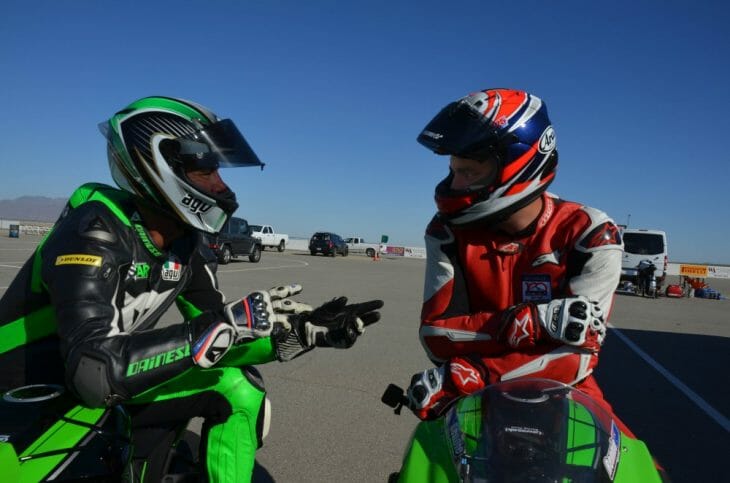 The guy on the left is a two-time Endurance World Champion. The guy on the right, is not! Therefore the guy on the right had better shut up and listen!
The guy on the left is a two-time Endurance World Champion. The guy on the right, is not! Therefore the guy on the right had better shut up and listen!
Smooth is fast, smooth is fast…
After a pretty respectable weekend’s racing at the first round of the Chuckwalla Valley Motorcycle Association Winter Series, I left the desert racetrack feeling pretty good. I’d nabbed a win, dropped my lap times down to somewhere that a few fast guys were telling me I was going well and the 2016 Kawasaki ZX-10R was behaving itself like a proper motorcycle that wanted to be thrashed, rather than it thrashing me.
We’ll have a full run-down on this particular version of project racer coming soon and if you’d like to read my first ride review of the bike from the world launch in Malaysia, click here, but for the next two days I’m back at Chuckwalla to break down my riding with style guru, former two-time Endurance World Champion and two-time AMA Pro Road Racing Champion, Jason Pridmore at his renowned Star Motorcycle School.
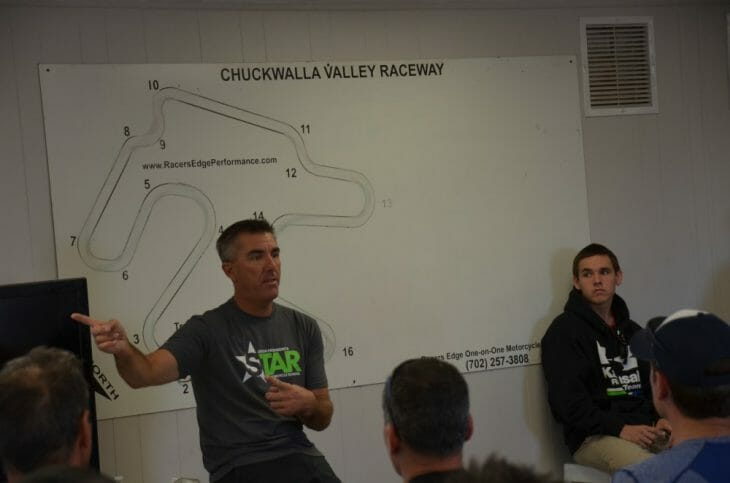 Jason laying down the law prior to day one.
Jason laying down the law prior to day one.
My background in racing has generally been on bikes 600cc and under, bikes that required high corner speed to get the laptime due to the fact they had very little horsepower. It’s only in the past five or so years I’ve really focused on adapting my style to ride fast (as in, race pace) on a superbike. Road and track testing pace is one thing, but to really push a 1000cc bike hard requires a different style to what I’m historically accustomed to. Snapping out of the ‘little bike style’ is far harder than I gave it credit for. That’s why I’ve got Jason Pridmore, or “JP” to many, and his army of instructors including Benny Solice, Caroline Olsen and Michael Gilbert (all MotoAmerica Supersport and Superstock 600 guns) trying to impart some vital knowledge and habits in the hope this old dog can learn some new tricks.
Jason Pridmore’s Star Motorcycle School has been running for 15 years and the guy has helped some very esteemed riders in this time. A good friend of mine is Australian Damian Cudlin, a rider many of you may recognize from his brief time here in the now defunct Daytona Sportbike series and in many other race series around the world including the EWC, German Superbike and Supersport, and MotoGP. Damian told me his riding had hit a bit of a plateau in 2009 before he started training with JP, but from then on his star (sorry for the pun) only got brighter. A year later, he was German Supersport Champion, a year after that he got his first ride in MotoGP. Coincidence? Maybe, but there’s no doubt JP seriously knows his stuff so I’ll be listening with every ounce of concentration I have.
The Star Motorcycle School breaks up into Expert and Intermediate levels, with about 10 riders per instructor. Across the course of the first day we work on two key points – body positioning and downshifting – with day two focusing a bit more on how to feel what the tires are doing, as well as ironing out irregularities in my riding, like braking technique, mid-to exit corner body positioning and the initial touch of the throttle when on the side of the tire. Smooth is fast has never been more appropriate than right now.
Downshifting smoothly is more important than what many people realize. I always thought I downshifted a bike pretty well, a skill I picked up during the thousands of hours spent on different bikes as a Road Test Editor in the U.S. and Australia, but I soon realize I’m not doing it fast enough on corner entry. Jason admits one of the things he prides himself on is his ability to downshift a motorcycle. While that may sound a bit odd, getting a fast, smooth shift done early in the deceleration zone is vitally important to keep the chassis stable and allow more time and concentration to be spent on braking and turning.
Practicing this yields immediate results. The second I get off the gas, I get the shift out of the way and get ready for the fast approaching corner. Lengthening the time between decelerating tasks (downshifting, braking and turning), makes the whole ride feel smoother and less tiring, and makes for a happier chassis.
According to Solice and Olsen, there are no major things I’m doing terribly wrong on the bike. My body positioning seems pretty good – although I need to keep my feet further forward on the rearsets and thus more bodyweight on the front-end to stop the Kawasaki wheelieing – I’m getting better set-up for the corners after a quick chat with Jason and I’m making a more concerted effort to keep my outside leg wedged into the rearset and gas tank to help keep me upright and enable the bike to turn tighter without any extra input from the handlebars.
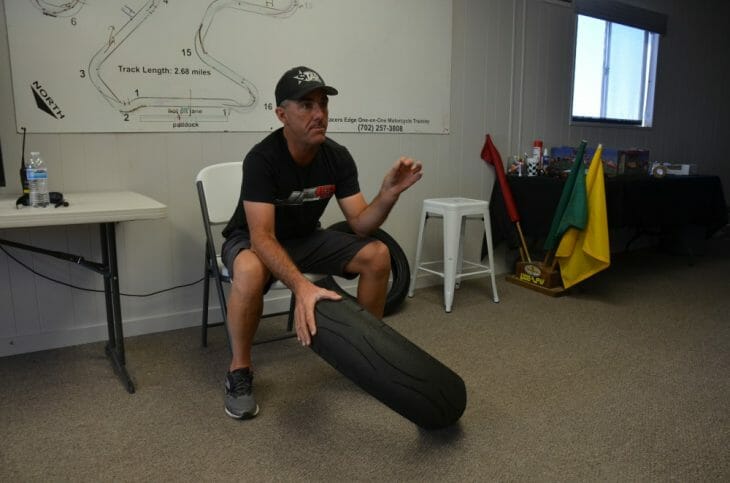 Gaining that feel for the tire will unlock huge amounts of rider confidence and shed seconds off your lap time.
Gaining that feel for the tire will unlock huge amounts of rider confidence and shed seconds off your lap time.
Where I tend to struggle, however, is diving for the corners too early. This particular riding issue is a double edged sword. At Pikes Peak this year, one of the areas I could make up a lot of time was in the hairpin corners. The KTM 1290 Super Duke R was great in that I could apex the corners really early and keep the bike tight for the exit without sacrificing too much exit speed and using all that torque the KTM had, but this is not the way to ride a 1000cc superbike.
Jason follows me for a few laps on Sunday, and immediately points out two things. The first is I need to open up the entry of the corner more. While my braking technique is pretty good and I’m braking in roughly the same place and at the same speed as Jason, I’m not carrying enough roll speed when I get off the brakes. Everyone remembers that epic battle between Rossi and Lorenzo in 2009 at Catalunya and Rossi let his brakes off into turn one and rode around the outside of Lorenzo with two laps to go, right? That’s a prime example of roll speed (start the video from 15 seconds in). Valentino braked only a touch later than Lorenzo, yet still rode around the outside of him due to higher roll speed.
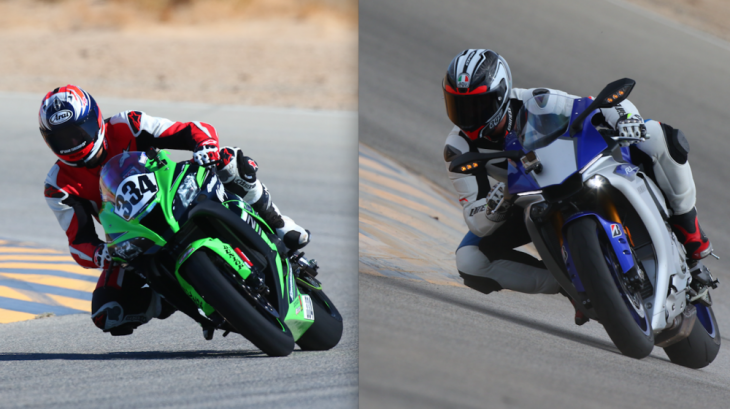 Two styles; two bikes; same corner; same rider. The left shot was taken last week, the right over a year ago. Rennie’s far more at ease in the left shot, but not putting enough lean angle in. He’s going much faster in the left shot but still has work to do on body positioning.
Two styles; two bikes; same corner; same rider. The left shot was taken last week, the right over a year ago. Rennie’s far more at ease in the left shot, but not putting enough lean angle in. He’s going much faster in the left shot but still has work to do on body positioning.
My roll speed on corner entry needs to be higher. Riding this way has three benefits: the first is the obvious increased corner speed; the second is the extra roll speed enables me to hold a higher rpm, meaning the bike won’t become as nervous when I get back on the throttle as I’ll be closer to the meat of the Kawasaki’s power, and can drive out of the corner harder and faster instead of waiting for the revs to build. And finally, the third benefit is a higher roll speed will naturally make me want to use a wider part of the track to maintain it, rather than sacrificing it in the name of slower mid-corner speed, lower revs, and lost time waiting for said revs to build.
Another area Jason comments on is the fact I’m not leaning the bike over far enough. Now, this one stumps me, a touch. Ever since I started to make a concerted effort to change my riding style from a high corner speed little bike to a point-and-shoot superbike, I’ve gradually moved myself more and more onto the seat, rather than hanging right off. Putting my weight more in the center of the seat enables more weight to go through the center on the chassis and into the tires, which in turn creates a fatter contact patch to feed the power into. Formerly, I’d hang right off the side of the bike, and my weight would thus be on the edge of the tire – which is its most compromised position in terms of safety and grip (it’s kind of like walking on the sole of your shoe and walking on the edge of your shoe, which is the most secure?).
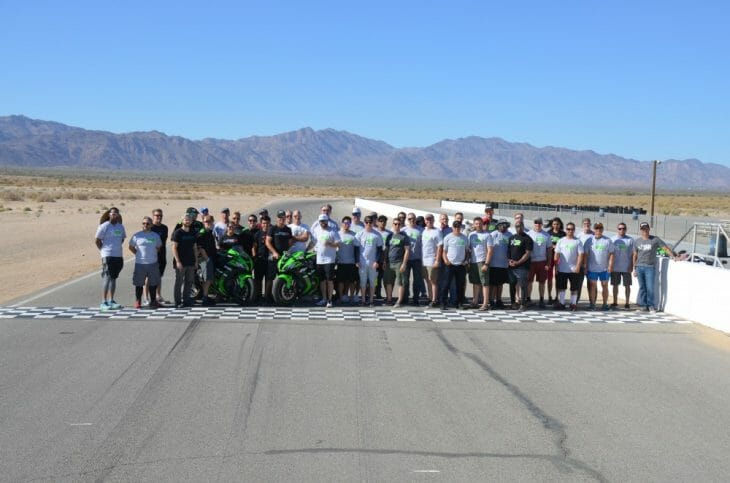 Another school of happy campers!
Another school of happy campers!
It appears I have gone too much in the wrong direction. I now realize I have to shift my weight a bit more off the side of the bike, keep my shoulders from slouching (i.e use more core muscles), and trust the front tire a bit more with some extra lean. This is much easier said than done, but I think this is the key to unlocking a couple of seconds per lap because my exit speeds are generally pretty good – it’s the entry and mid-corner where I suffer.
I’m not a rider that uses a lot of rear brake, although I know it will help me a lot. This is a mindset I must change if these changes are going to have any effect on my results and overall speed. Dragging the rear brake a touch helps settle the back end on mid-to corner exits, and makes it easier to lay down the power nice and hard without the back end pumping and breaking traction, so that’s another area to work on.
I’d recommend doing the Star Motorcycle School to anyone who wants to get faster. Even if you’re a road rider, doing a school such as this will impart some vital new skills and you might even catch the racing bug!
I’ve got a break between now and round two of CVMA at the end of October, so I’ll be doing my best not to forget the lessons Jason and his excellent crew of instructors taught me!